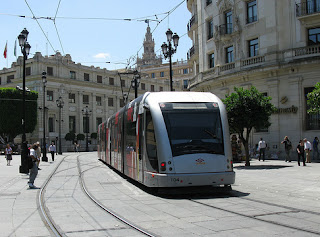We arrived in Seville by bus from Faro, Portugal, about mid day and took a taxi to our hotel, the Al-Andalus Palace (H on the city map), a huge 600+ room 60s era hotel that looked like in belonged in Las Vegas, but was very comfortable, on a bus line, and a bargain.
Then on to the Cathedral. The tower, La Giralda, was build as the minaret for the original mosque, but is now the bell tower of the cathedral.

…and the Alcázar, the palace. I was castled-out at this point, and we didn’t take the tour. Next time.
…and lots of shops and cafes.

The menú turistica looked pretty good, in all five languages, but it was early for comida, so we just had a beer.
The Plaza de Torros was a on the river front, a few blocks from the center.
And across the river, the Guadalquivir , is the barrio La Triana, where we had “tapas” at a what turned out to be a snack bar—frozen fast food, not recommended.
And in the evening we went to a flamenco show,
Where we saw a group very much like this one:
We liked Seville
 Leaving
Leaving A few doors down was a sherry bodega that sold its wines from the casks to the folks in the neighborhood and the occasional tourist. After sampling a bit of everything we bought a 2 lt. plastic bottle—the only size they sold—of oloroso. I enjoyed the first few glasses.
Santa Marta, said to have been founded by an “Athenian leader in the days of the Trojan War named Menesteo,” also has a castle, the Castle of San Marcos, built over the remains of a 10th century Islamic mosque in 1364. But touring hours were too late for us; we were on our way to Ronda.
From Santa Marta
Ronda was one of the most interesting cities we visited. The old city is on a cliff-top island, separated from the modern town by an incredible chasm.
The “new” bridge, constructed from1751 to 1793, is 120 m. high. It connects the new town, to the right, with the original city (behind the camera) built by the Romans.
The view across the canyon from the old city.
The old city.
The “old bridge,” from the “Arab bridge.
Gate at the Arab Bridge
The plaza of the new city of Ronda
And then off on a rainy afternoon to Granada





























Que fantástico viaje Jim!!! La verdad es que leyendo y viendo las primeras fotos me encantó Sevilla, pero luego de ver las imágenes de Ronda (ciudad que nunca antes había oído) quedé maravillada, realmente preciosa. Me gustaron mucho las calles, el puente y la plaza, se nota que lo pasaron muy bien. Te ves muy bien junto al auto rentado!!!! Eres un muy buen relator de viajes, tengo un libro que creo te gustaría ver, ya que es una bitácora de viajes con muchos dibujos y leyendas. Un abrazo, Javi
ReplyDeleteGracias, Javi. Y si, me gusta prestar el libro.
ReplyDeleteJim